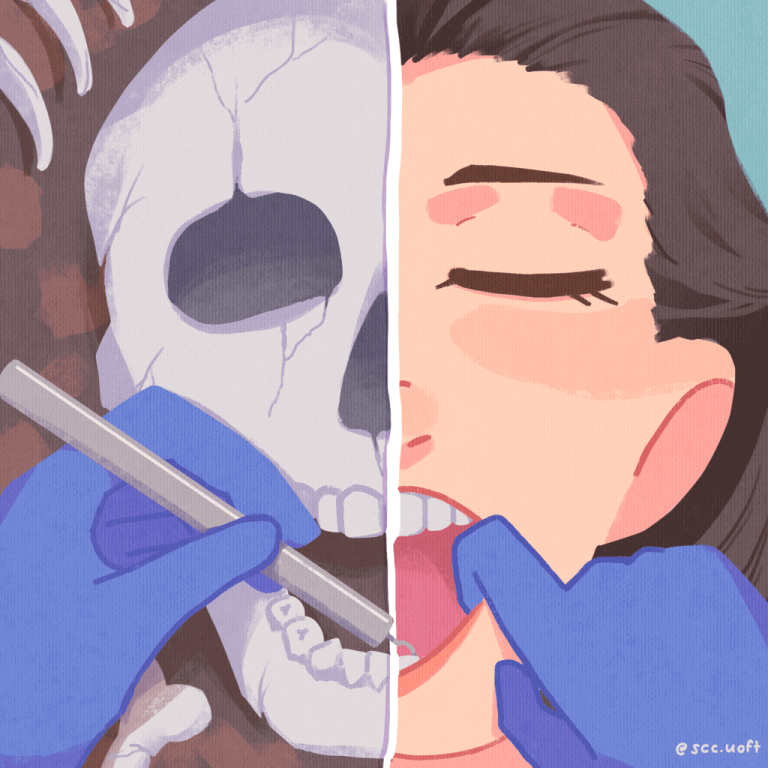
Written by Quinn Lui
Illustrated by Shanling Lei
For a lot of people, visiting the dentist can be an exposing experience. Just by looking at their patients’ teeth, dentists can tell who’s been enjoying sugary drinks, or who skips flossing. As it turns out, dental bioarchaeologists can learn a lot from analyzing the teeth of prehistoric humans, too! Luckily for them, teeth usually last longer than bones, making them easier to find at archaeological sites.
One device that is used to examine prehistoric teeth is Artificial Resynthesis Technology (ART), which imitates the chewing motions made by the human jaw. Different foods wear teeth down in different ways, meaning that scientists can figure out an ancient human’s diet by working backwards from ART data! For example, hominins from as early as four million years ago were beginning to develop thicker enamel layers on their teeth. Because enamel helps protect the teeth from wear, this tells us that they were transitioning away from consuming only fruit, and eating seeds, nuts, and even other animals as well.
Aside from what food was being eaten, inferences can be drawn about the health challenges faced by prehistoric humans. Vertical lines called hypoplasias appear on a tooth when enamel formation is interrupted for some time, which can point to long periods of malnutrition. However, in some cases, they might have been healthier than we are! According to their teeth, the ancient people of what is now Greece had better Vitamin D levels and lower cavity rates than their modern counterparts.
Teeth can give insight into our evolutionary history, too. An imaging technique known as synchrotron x-ray technology can detect growth lines in ancient teeth. Also called perikymata, these lines reveal how long it takes for teeth to form. Conventional wisdom says that the farther back in time we travel, the more quickly our ancestors’ teeth developed. Since day-to-day survival was more demanding than it is now, it was a disadvantage for children to be overly reliant on their parents for too long. However, the molars of a six-year-old from northern China revealed that their teeth had formed at a rate unexpectedly similar to a modern child’s, despite living at least 104,000 years ago.
We’re also in long-standing company when it comes to trying to take care of our teeth. Using a light microscope, researchers were able to detect scratches on the teeth of a Neanderthal who lived in Croatia around 130,000 years ago. The scratches had been caused by continuous poking from a toothpick-like tool, probably in an attempt to ease the discomfort of a misaligned tooth. Fortunately for us, dental care has come a long way since then!
Sources:
- https://www.smithsonianmag.com/science-nature/ancient-teeth-reveal-our-roots-180969495/
- https://www.dentistry.umn.edu/research/minnesota-dental-research-center-biomaterials-and-biomechanics/expertise-and-competencies/simulation-oral-challenges
- https://www.sciencedaily.com/releases/2019/01/190116150636.htmhttps://www.sciencedaily.com/releases/2017/06/170628131510.htm